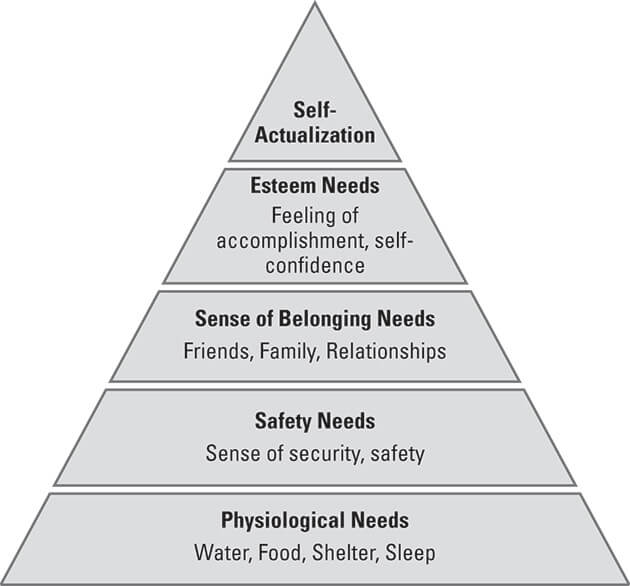- A home provides for you physically, such as protection against weather, outside elements, a place to sleep, to eat, and to be safe.
- A home provides emotional security. You can find a place to relax in privacy and comfort. Your decor might even reflect your taste.
- A home provides you with a social atmosphere that gives you a sense of belonging and love. Your home might serve as a gathering place for family and friends to live, work, and play together.
 ©John Wiley & Sons, Inc.
©John Wiley & Sons, Inc.When your housing serves an emotional and social need, it’s more than just a roof over your head. It becomes a home.
When is it time to move out on your own?
How can you determine when it is time to move out and get a place on your own? When is it time to create that sense of belonging and security in your own home? The time is different for each individual.The following are some indicators that it may be time to move out of your parents’ house, family members’ house, or other current living situation.
- You begin to feel like you do not have ownership over your personal items, even if you purchased them.
- You have an emergency fund in savings.
- Your schedule is the opposite of those you live with and you begin to feel uneasy coming home at crazy hours.
- You want a pet, but they are not allowed in your current living situation.
- You want more privacy.
- You cannot decorate your space to express your creativity.
- You already pay most of your own bills.
- Your mental health is affected negatively by your living situation.
Living in a place of your own brings a sense of accomplishment but also much more responsibility.
Considering your housing needs and wants
When it comes to housing, people have different needs and wants. You may think something is necessary for a home, but others may see it as a drawback. Here are some questions to consider when thinking about housing:Size
- How many people will be living in the space?
- Will you need room for regular guests and visitors?
- What will the space be used for? For example, will you need a work space or home office?
Stage of life
- Is this your first time living on your own?
- Are you married with children?
- Do you need space to take care of your extended family?
Special considerations
- Do you or a family member have a special need regarding mobility?
- Do you need to be close to public transportation or a safe area to walk for a person with vision impairment?
- Will elderly individuals be living with you?
Location
- Is it important to live close to your school, job, or place of worship?
- Would you rather live in a busy city neighborhood, a quiet part of town, or in the country?
- Do you want quick access to stores, restaurants, or public transportation?
- Is the size of the city important to you?
Lifestyle
- What type of day-to-day living is important?
- Do you want to be close to friends and places for an active nightlife?
- Will you be working from home?
Financial considerations
- Is there a high cost of living in the area?
- Does the neighborhood require a home owners association (HOA) fee?
- Does the house require extra maintenance, such as caring for a pool or large landscapes?
Location may not be in the forefront of your mind when looking at some eye-catching housing options, but trust me, you will thank yourself later if you focus on where your house is located.
Different types of housing
After you've decided what type of location you want to live in, you have to consider the types of housing available. Depending on the location, you might have many options available to you, or you might be limited. The two most common types of housing are stand-alone housing and multi-dwelling units:Stand-alone housing has the following characteristics:
- Built to house one individual or a family
- Is freestanding — not sharing any walls with another unit
- Can be large, small, or multiple stories tall
- Offers more privacy than multi-dwelling units
- Is usually a more expensive option than other types
- Contain several housing units in one structure
- Can be a duplex, which is one building with two separate units that share one wall; one person usually owns both units and either rents both or lives in one and rents out the other
- Can be multiplex housing, which is where three or more units share the same building, such as a condo, which can be rented or owned
- Can be considered a townhome, where the single-family home is at least two floors and shares one wall with another house. Each townhome is individually owned
- Can be apartments; an apartment building is a structure that has multiple rental units; apartments range from three or four units to high-rise apartments that have hundreds of units; an apartment complex has separate buildings with units grouped together for rent.
- Include student housing such as dorm units
- Often are more affordable than stand-alone housing
- Are readily available and can be used for a short or long amount of time
- May include shared laundry facilities, pool area, workout area, or other special features
- Are usually less private than a stand-alone dwelling
- Have limited storage, yard area, and parking
- May not allow pets
When attending a college or university, many students choose to live in student housing. A dorm room is a small, shared space that consists of one room for sleeping, eating, entertainment, and studying. Many students feel that living in student housing allows them to meet new people and experience everything college life has to offer.
Throughout your life, you will likely live in different types of housing. Depending on your stage of life, it might be time to downsize or upsize.Later, you may find yourself taking care of your parents, much like a role reversal; they might need to live with you or consider other options such as retirement homes with senior living care.
Taking care of your aging family members is a large responsibility that should be done with the upmost dignity and respect. After all, they did raise you into the amazing human you are today!

